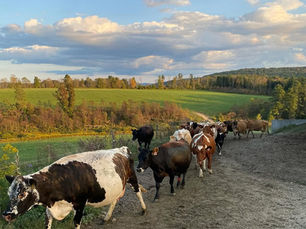Grass Is Transformational
- mackenziehartung
- Sep 25, 2024
- 3 min read
We’re big believers in the power of grass. We know grass is the best food for cows, and feeding a 100% grass-fed diet helps make the most delicious milk out there. But did you know that in some cases, grass is the only thing that a plot of land can grow?
Why is Grass so Important for Making Delicious Dairy?
Grass is resilient, adaptable, and can thrive in soil where other crops would struggle. Unlike vegetables and grains that need fertile, well-drained soil, grass can grow in compacted, rocky, or sandy soils that lack nutrients and water retention. This is largely because grass has deep root systems that access nutrients and moisture from deep within the soil, making it a great option for less-than-ideal conditions. And we think that makes some plots of land the perfect place to feed our cows. Because across our farms, cows aren’t just munching on grass all day; they’re actually spending all day improving and transforming the soil as they graze.

Photo taken at one of Maple Hill's Family Farms.
Cows are natural grazers and their unique four-chamber stomach system that allows them to digest tough, fibrous plants like grass. Their grazing habits make them perfect for lands where grass is the main vegetation. By letting cows graze on these lands, farmers can use areas that wouldn't support traditional crops.
With so many varieties of grass, grass rarely meets a soil it can’t live in. And that means we can make the most of land that would have to be significantly manipulated to support human food agriculture. So, we plant grass, and then let our cows do the rest. Grazing cows are key to the regenerative system, because they naturally fertilize, aerate, and stimulate the soil under them. When cows graze, they naturally deposit manure across the landscape that is rich in essential nutrients that came from their grass-fed diet to begin with (yes, literally they’re returning nutrients back to the soil!). That manure is crucial for plant growth and soil fertility. As they graze and pull up grass, they also help stimulate plant growth. When the tops of plants are pulled up by a cow’s mother, the roots respond by growing deeper and spreading out more. This helps to stabilize the soil and improves its structure over time. Their hooves help to break up compacted soil, which improves soil aeration and water infiltration. Rotational grazing, or managed grazing, (which is the practice of containing and moving animals through pasture to improve soil, plant, and animal health) helps to distribute manure more evenly across the landscape. This way, we make sure nutrients are spread throughout the grazing area, rather than being concentrated in specific spots.
Before you know it, the soil that could only support grass becomes a rich, nutrient-rich soil that can support biodiverse plant and animal life. By using the unique strengths of cows and the resilience of grass, farmers can turn otherwise unproductive soil into valuable resources, all while replenishing and improving it– and while making incredibly delicious dairy. This way, there’s less pressure to use fertile land for livestock, and instead, that land can be used for growing human food crops and vegetables. It’s smart, sustainable, and regenerative.
At Maple Hill, we’ve been committed to regenerative practices since 2009 because we know the highest quality dairy begins with the health of soil, grass, and cows. We believe that 100% grass-fed organic dairy farming done right is the pinnacle of organic, nourishes families with the best nutrition, and leaves the earth better than we found it. We are proud to be selected as a USDA Climate Smart Partner — supporting the production of climate smart commodities throughout the United States.
Our 100% Grass-fed Organic dairy products include: 100% grass-fed whole milk, 100% grass-fed 2% reduced fat milk, 100% grass-fed butter (salted and unsalted), 100% grass-fed kefir (plain, vanilla, and strawberry), 100% grass-fed greek yogurt (plain and vanilla bean), and 100% grass-fed cream-on-top yogurt (plain and vanilla).









